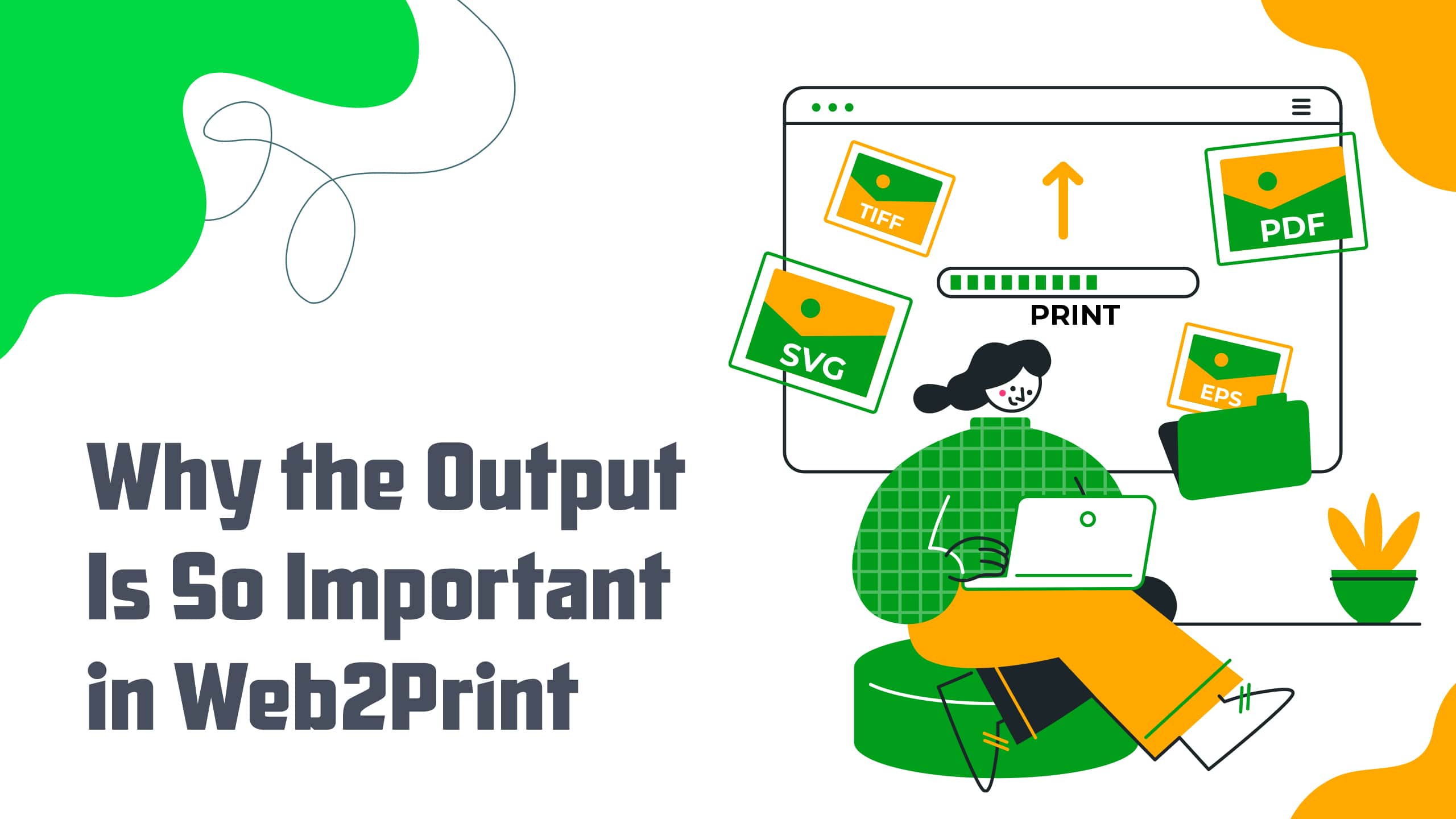
With the rise of digital technologies, especially Web2Print, the custom printing business has dramatically changed. People in this niche use web technology and traditional printing methods to make personalized goods that are printed only when needed.
“Output” means the finished printed product that the customer receives. It shows the quality and accuracy of the original digital design turned into a physical form. Choosing the best file format for printing is crucial to achieving crisp, vibrant results.
The Crucial Role of High-Quality Output
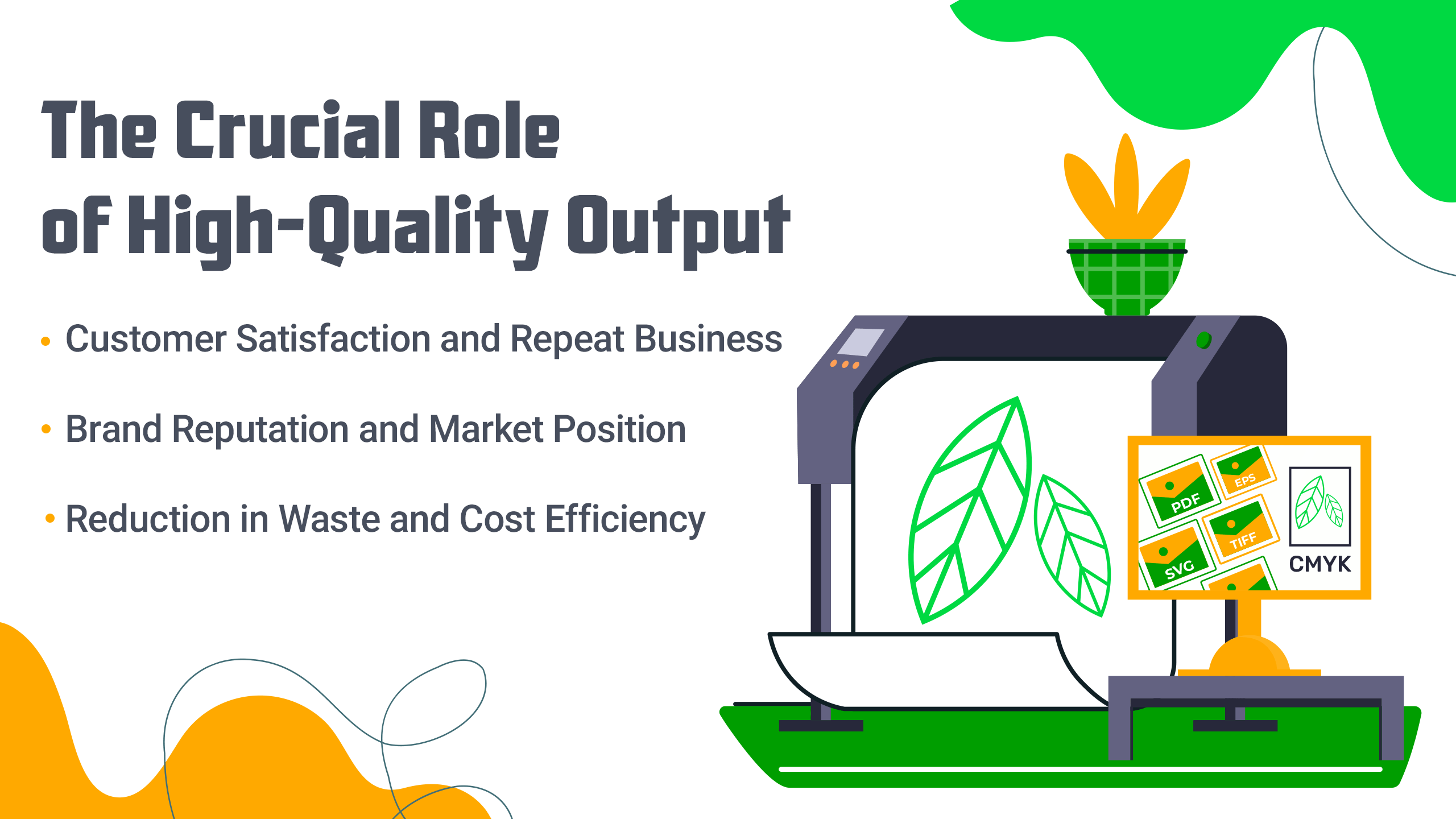
> Customer Satisfaction and Repeat Business
Customers are happier with well-made goods that have clear images and accurate colors. This makes them more likely to place similar orders again. Also, high-quality products get good reviews and recommendations from other people, which is very important today when digital testimonials can significantly impact buying choices.
> Brand Reputation and Market Position
The quality of a company's work can significantly affect its brand image. People are more likely to trust and buy from companies that consistently offer high-quality printed products. This helps them gain a stronger position in the market. This name for quality helps you stand out from the competition and bring in new customers while keeping old ones.
> Reduction in Waste and Cost Efficiency
Consistently high-quality output also helps make operations run more smoothly. Less writing mistakes mean less waste of paper and other resources, which not only saves money but also helps businesses be more eco-friendly. When it comes to printing, where raw materials can cost a lot, making good use of resources is especially important.
Challenges in Achieving High-Quality Output
> Technological Integration
A big task for Web2Print services is keeping up with the latest technology while producing high-quality work. This includes not only the printers themselves but also the design and layout tools, color management systems, and the digital-to-physical conversion processes that need to keep the integrity of the original design.
> Skilled Workforce
Technical knowledge is crucial, as are skilled workers who can use modern printing technology well, fix problems, and ensure quality is always the same. It is important to remember that people are still needed to check and maintain output quality, even though automation has come a long way.
> Supply Chain Management
More than good equipment and skills are needed to print well; the raw materials must also be of good quality. A steady supply of high-quality inks, papers, and other materials can be hard to find, affecting the quality of the final result.
The Nature of Custom Printing
Custom printing services include a wide range of options to meet a wide range of personal and business needs. Printing custom clothes and sports outfits is one of these services. Other services include making promotional materials and large-format prints in interior design and advertising. Each segment not only shows how flexible the printing business is but also shows how well it can meet specific customer needs.
Different Types of Customer Needs
Like the services they offer, the people who use them are also very different. A local sports team, for instance, might need jerseys that are made just for them with their colors, names, and numbers. However, a company may need banners, flyers, and marked items such as pens and notebooks to sell itself. So, an artist or photographer might want high-quality large prints that faithfully capture the color and detail of the originals. The fact that these are all different shows how important it is for custom printing services to be able to adapt quickly and meet a lot of different design and function needs.
Why Customization Is Important
The custom printing business is all about making things unique. Brand-name, mass-produced things can't compare to their unique value. For companies, customized materials are important for building a brand and standing out in a crowded market. Personalized items, such as custom clothing or gifts made just for you, are meaningful to you and show off your tastes and preferences.
Customization also makes it easier for customers to get involved. Businesses can make the experience more personal and memorable for customers by letting them help with the design process. This builds loyalty and happiness. This involvement can include anything from picking out colors and fonts to adding text and pictures sent in by users.
Optimal Output for Efficient Production
So, what is the best file format for t-shirt printing? For the custom printing business, having design files that are ready to use right away speeds up the production process. When making signs, stickers, and large-format prints, having a production-ready output file means that these things can be sent to print right away without needing any other changes. This setup gives producers a real-time preview, which lets them quickly confirm the design and start production.
When it comes to clothes and outfits, however, the process needs a little more planning. For optimal clarity and color accuracy on your custom apparel, selecting the best file format for t-shirt printing is essential. To get these things ready for production, it's important to make sure that there are unique patterns for each print area on the clothes.
Benefits of Having an Appropriate Output
> Reduced Returns and Refunds: Having production-ready files minimizes the likelihood of errors during printing, which in turn decreases the rate of returns and refunds. This not only saves costs but also reduces the logistical hassle of reprocessing returns.
> Decreased Need for Graphic Designer Intervention: How to prepare images for large format printing? When files are prepared correctly and adjusted for immediate production, there is less need for graphic designers to step in and make corrections or modifications, which can be costly. This reduction in labor not only lowers overall production costs but also speeds up the time to market.
> Enhanced Customer Satisfaction: With streamlined processes, customers enjoy a more straightforward proofing process. They can quickly approve proofs without the need for back-and-forth adjustments, leading to faster delivery times and higher satisfaction rates.
Common Output Formats
Which format is best for printing posters, the best file format for printing business cards and other apparel? The standard output format in the custom printing industry, particularly for online design submissions, is the Portable Document Format (PDF). Most online design software vendors favor this format due to its versatility and reliability in preserving the integrity of the design across different platforms and printing systems.
To ensure optimal print quality, it's important to know how to format a PDF for printing by setting the correct resolution, color mode, and including necessary bleeds.
Importance of Color Spaces
It is crucial to consider color spaces—such as RGB (Red, Green, Blue) for digital displays and CMYK (Cyan, Magenta, Yellow, Key/Black) for print—when creating output files. The correct color space ensures that the colors in the digital design will accurately translate into printed materials.
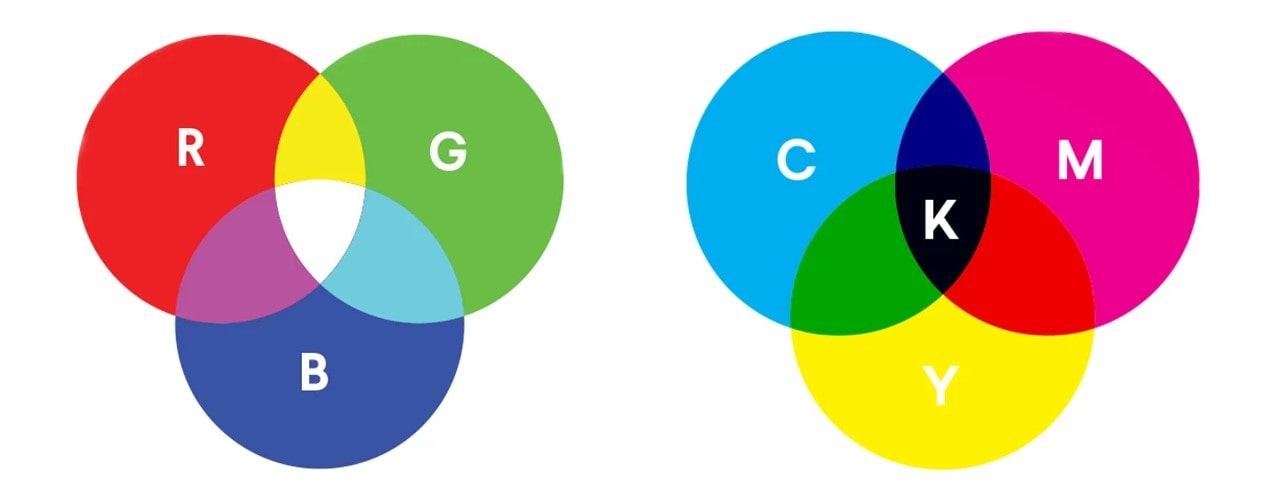
Advantages of PDF
PDFs are particularly beneficial for both back-office proofing and front-line production. They support detailed descriptions and can embed exact color profiles, which ensures that what you see on screen is what gets printed. This reliability makes PDFs a staple in the printing industry.
Incorporating Other Formats
While PDF is standard, other formats like Illustrator (AI), CorelDraw (CDR), and Encapsulated PostScript (EPS) are also used and have their respective strengths, especially in vector-based designs which are essential for scalable prints. LiveArt, for example, champions quality by encouraging the submission of pre-made design examples in these formats. Although these formats are highly effective, converting them to Scalable Vector Graphics (SVG) can be advantageous for consistent application across different printing technologies.
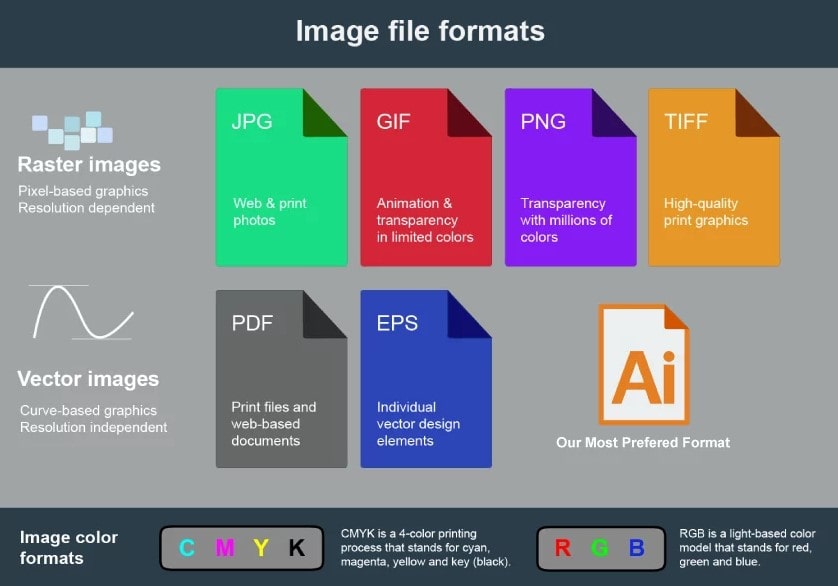
Frequent Output Adjustments
From sending in the design to getting the final output, there are often changes that need to be made to make sure the print quality is perfect and the product specs are met. These changes affect different parts of the output files, like the format, size, bleeds, and what needs to be done afterward.
Common Tweaks to Standard Vector PDF Outputs
What is the most popular and high-quality file format typically used for printing? Vector PDF is one of the best file formats for printing because it can be scaled up or down and stay true to the original when printed. Even so, these files sometimes need to be changed to meet certain printing standards or to fix mistakes that happen when they are changed from design software to print-ready forms. Some common changes that can be made are to finetune line thickness to improve print clarity, change color profiles to fit CMYK standards for printing or change text embedding to stop problems with font substitution.
Format Adjustments for Different File Types
While PDFs are the standard, there are scenarios where other file formats like TIFF or EPS might be more suitable due to their specific attributes:
> TIFF: This format is preferred for high-resolution raster images in large format prints where detail preservation is critical. Adjustments in TIFF files often involve setting correct compression parameters to avoid data loss while keeping file sizes manageable. For vibrant and precise results, the best format for sublimation printing is typically a high-resolution PNG or TIFF file.
> EPS: Often used for complex vector graphics involving intricate designs, EPS files can be adjusted for better compatibility with different printing systems, ensuring all elements render correctly without errors.
Resolution Appropriate Settings
Image resolution for large format printing settings is crucial, especially for raster-based formats where image clarity and detail are essential. The typical standards are:
> 300 dpi: Suitable for most prints where close-up viewing is expected, such as flyers or brochures. It's essential to adhere to the minimum dpi for large-format printing to ensure that images are clear and detailed.
> 600 dpi: dpi for large format printing, used for high-detail prints, such as intricate artwork reproductions or detailed photographs.
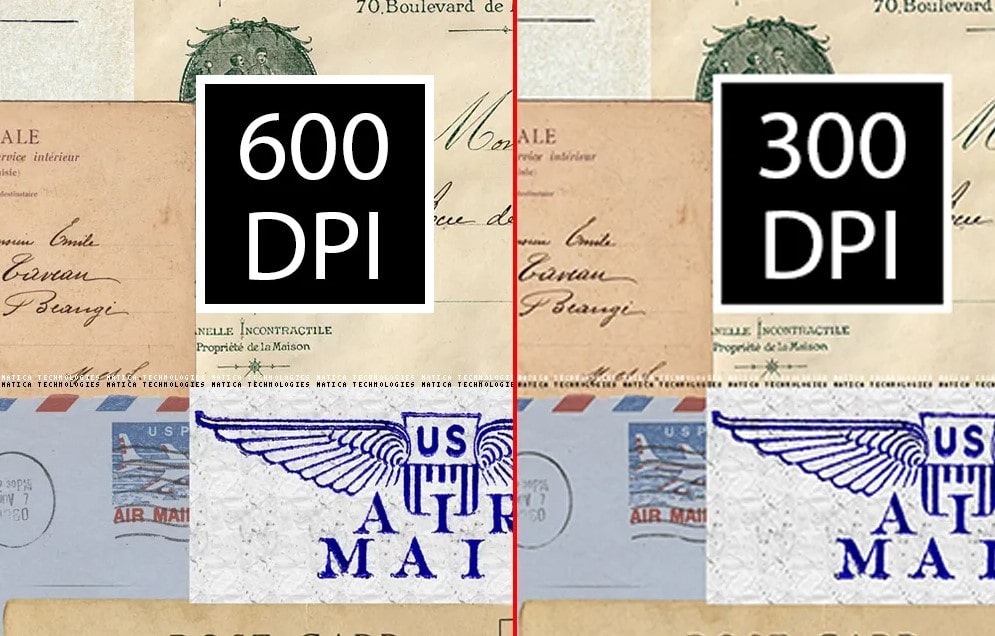
Adjusting the resolution is crucial to avoid pixelation in final prints, ensuring that images appear sharp and clear.
Bleeds: Managing Placement in Output Files
Bleeds are extra areas of the design that extend beyond the page borders, crucial in signs and large-format printing to ensure edge-to-edge coverage without white margins. Managing bleed placements involves setting the correct margins and ensuring that background colors or patterns extend into this area to achieve flawless trimming.
Post-Processing: Enhancing Final Outputs
Post-processing tweaks enhance the functionality and aesthetic of the final product:
> Raster Filters: Applied to smooth out edges or enhance image quality, raster filters are particularly useful in adjusting the final appearance of raster images in the specialized output printing file.
> Integrating Product Images: Adding high-quality images of the product to the design file can help in visualizing the final product more realistically, which is especially useful in promotional materials.
> Adding Essential Information: Including SKU numbers, product colors, and other relevant details directly in the mockup ensures all pertinent information is accessible, which simplifies inventory management and quality control.
Impact of Output Quality on Customer Satisfaction
Customers' opinions are greatly affected by the quality of the work you do, which makes them happier and more likely to trust your brand. Well-done goods show professionalism and skill, which has a direct effect on customer approval.
Quality directly leads to repeat sales and customer loyalty. Customers who are happy with a service are likely to tell others about it, which helps the business grow naturally through word of mouth.
Challenges in Achieving High-Quality Output
> Technical: Color accuracy and material variability can impact print consistency.
> Logistical: Managing large or complex orders and high customization demands can strain resources.
Investing in new printing technology and teaching staff regularly makes sure that a wide range of projects are handled quickly and well, with both technical and logistical problems being solved.
The Role of Quality Assurance
Quality control is crucial for maintaining product integrity and consistency, helping identify and correct defects before reaching the customer. Practices include pre-production proofs, equipment calibration, and systematic production checks, crucial for maintaining high standards.
Quality assurance ensures reliable output quality, enhancing customer satisfaction and strengthening the brand’s market reputation. By maintaining high standards, companies can ensure customer trust and loyalty, reinforcing their competitive edge in the market.
Conclusion
Being focused on quality will become even more important as technology improves and customer standards rise. Companies that keep spending money on the newest printing technologies, training for their employees, and strict quality control methods will be able to stand out in a crowded market. Maintaining high-quality standards and changing to meet changing customer needs is very important for the printing industry's future.
Contact us today to find out how our top-notch custom printing development services can help your brand and grab people's attention!